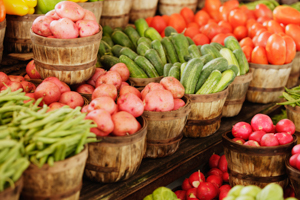Vitamins: Their Functions and Sources
Topic Overview

The tables below list the vitamins, what they do in the body (their functions), and their sources in food.
Water-soluble vitamins
Water-soluble vitamins travel freely through the body, and excess amounts usually are excreted by the kidneys. The body needs water-soluble vitamins in frequent, small doses. These vitamins are not as likely as fat-soluble vitamins to reach toxic levels. But niacin, vitamin B6, folate, choline, and vitamin C have upper consumption limits. Vitamin B6 at high levels over a long period of time has been shown to cause irreversible nerve damage.
A balanced diet usually provides enough of these vitamins. People older than 50 and some vegetarians may need to use supplements to get enough B12.
|
Nutrient |
Function |
Sources |
|---|---|---|
|
Thiamine (vitamin B1) |
Part of an enzyme needed for energy metabolism; important to nerve function |
Found in all nutritious foods in moderate amounts: pork, whole-grain or enriched breads and cereals, legumes, nuts and seeds |
|
Riboflavin(vitamin B2) |
Part of an enzyme needed for energy metabolism; important for normal vision and skin health |
Milk and milk products; leafy green vegetables; whole-grain, enriched breads and cereals |
|
Niacin (vitamin B3) |
Part of an enzyme needed for energy metabolism; important for nervous system, digestive system, and skin health |
Meat, poultry, fish, whole-grain or enriched breads and cereals, vegetables (especially mushrooms, asparagus, and leafy green vegetables), peanut butter |
|
Pantothenic acid |
Part of an enzyme needed for energy metabolism |
Widespread in foods |
|
Biotin |
Part of an enzyme needed for energy metabolism |
Widespread in foods; also produced in intestinal tract by bacteria |
|
Pyridoxine (vitamin B6) |
Part of an enzyme needed for protein metabolism; helps make red blood cells |
Meat, fish, poultry, vegetables, fruits |
|
Part of an enzyme needed for making DNA and new cells, especially red blood cells |
Leafy green vegetables and legumes, seeds, orange juice, and liver; now added to most refined grains |
|
|
Cobalamin (vitamin B12) |
Part of an enzyme needed for making new cells; important to nerve function |
Meat, poultry, fish, seafood, eggs, milk and milk products; not found in plant foods |
|
Ascorbic acid (vitamin C) |
Antioxidant; part of an enzyme needed for protein metabolism; important for immune system health; aids in iron absorption |
Found only in fruits and vegetables, especially citrus fruits, vegetables in the cabbage family, cantaloupe, strawberries, peppers, tomatoes, potatoes, lettuce, papayas, mangoes, kiwifruit |
Fat-soluble vitamins
Fat-soluble vitamins are stored in the body's cells and are not excreted as easily as water-soluble vitamins. They do not need to be consumed as often as water-soluble vitamins, although adequate amounts are needed. If you take too much of a fat-soluble vitamin, it could become toxic. Your body is especially sensitive to too much vitamin A from animal sources (retinol) and too much vitamin D. A balanced diet usually provides enough fat-soluble vitamins.
|
Nutrient |
Function |
Sources |
|---|---|---|
|
Vitamin A (and its precursor*, beta-carotene) *A precursor is converted by the body to the vitamin. |
Needed for vision, healthy skin and mucous membranes, bone and tooth growth, immune system health |
Vitamin A from animal sources (retinol): fortified milk, cheese, cream, butter, fortified margarine, eggs, liver Beta-carotene (from plant sources): Leafy, dark green vegetables; dark orange fruits (apricots, cantaloupe) and vegetables (carrots, winter squash, sweet potatoes, pumpkin) |
|
Vitamin D |
Needed for proper absorption of calcium; stored in bones |
Egg yolks, liver, fatty fish, fortified milk, fortified margarine. When exposed to sunlight, the skin can make vitamin D. |
|
Vitamin E |
Antioxidant; protects cell walls |
Polyunsaturated plant oils (soybean, corn, cottonseed, safflower); leafy green vegetables; wheat germ; whole-grain products; liver; egg yolks; nuts and seeds |
|
Vitamin K |
Needed for proper blood clotting |
Leafy green vegetables such as kale, collard greens, and spinach; green vegetables such as broccoli, brussels sprouts, and asparagus; also produced in intestinal tract by bacteria |
Related Information
Credits
ByHealthwise Staff
Primary Medical Reviewer Kathleen Romito, MD - Family Medicine
E. Gregory Thompson, MD - Internal Medicine
Specialist Medical Reviewer Rhonda O'Brien, MS, RD, CDE - Certified Diabetes Educator
Current as ofMarch 29, 2018
- Top of Page
Next Section:
Related Information
Previous Section:
Topic Overview- Top of Page
Next Section:
Credits
Previous Section:
Related Information- Top of Page
Current as of: March 29, 2018